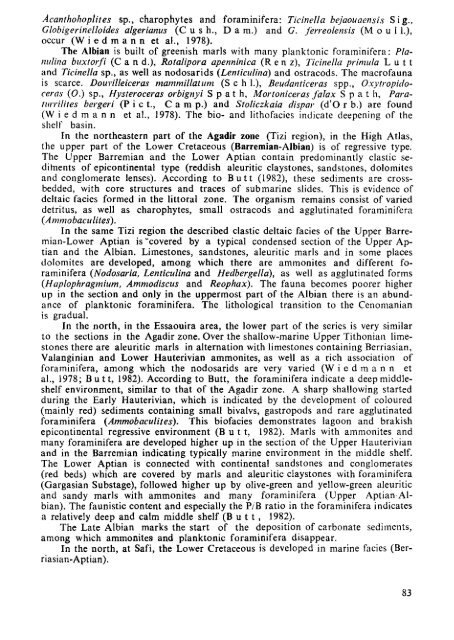THE MEDITERRANEAN LOWER CRETACEOUS
THE MEDITERRANEAN LOWER CRETACEOUS
THE MEDITERRANEAN LOWER CRETACEOUS
You also want an ePaper? Increase the reach of your titles
YUMPU automatically turns print PDFs into web optimized ePapers that Google loves.
Acanthohoplites sp., charophytes and foraminifera: Ticinella bejaouaensis Sig.,<br />
Globigerinelloides algerianus (C u s h., Da m.) and G. ferreolensis (Moul 1.),<br />
occur (Wiedmann et al., 1978).<br />
The Albian is built of greenish marls with many planktonic foraminifera: Planulina<br />
buxtorfi (Can d.), Rotalipora apenninica (Ren z), Ticinella primula L u 11<br />
and Ticinella sp., as well as nodosarids (Lenticulina) and ostracods. The macrofauna<br />
is scarce. Douvilleieeras mammillatum (S с h 1.), Beudanticeras spp., Oxytropidoceras<br />
(0.) sp., Hysteroceras orbignyi Spath, Mortoniceras falax Spath, Paraturrilites<br />
bergeri (P i с t., Cam p.) and Stoliczkaia dispar (d'O r b.) are found<br />
(Wiedmann et al., 1978). The bio- and lithofacies indicate deepening of the<br />
shelf basin.<br />
In the northeastern part of the Agadir zone (Tizi region), in the High Atlas,<br />
the upper part of the Lower Cretaceous (Barremian-Albian) is of regressive type.<br />
The Upper Barremian and the Lower Aptian contain predominantly clastic sedilnents<br />
of epicontinental type (reddish aleuritic claystones, sandstones, dolomites<br />
and conglomerate lenses). According to Butt (1982), these sediments are crossbedded,<br />
with core structures and traces of submarine slides. This is evidence of<br />
deltaic facies formed in the littoral zone. The organism remains consist of varied<br />
detritus, as well as charophytes, small ostracods and agglutinated foraminifera<br />
(Ammobaculites).<br />
In the same Tizi region the described clastic deltaic facies of the Upper Barremian-Lower<br />
Aptian is "covered by a typical condensed section of the Upper Aptian<br />
and the Albian. Limestones, sandstones, aleuritic marls and in some places<br />
dolomites are developed, among which there are ammonites and different foraminifera<br />
(Nodosaria, Lenticulina and Hedbergella), as well as agglutinated forms<br />
(Haplophragmium, Ammodiscus and Reophax). The fauna becomes poorer higher<br />
up in the section and only in the uppermost part of the Albian there is an abundance<br />
of planktonic foraminifera. The lithological transition to the Cenomanian<br />
is gradual.<br />
In the north, in the Essaouira area, the lower part of the series is very similar<br />
to the sections in the Agadir zone. Over the shallow-marine Upper Tithonian limestones<br />
there are aleuritic marls in alternation with limestones containing Berriasian,<br />
Valanginian and Lower Hauterivian ammonites, as well as a rich association of<br />
foraminifera, among which the nodosarids are very varied (W i e d m a n n et<br />
al., 1978; Butt, 1982). According to Butt, the foraminifera indicate a deep middleshelf<br />
environment, similar to that of the Agadir zone. A sharp shallowing started<br />
during the Early Hauterivian, which is indicated by the development of coloured<br />
(mainly red) sediments containing small bivalvs, gastropods and rare agglutinated<br />
foraminifera (Ammobaculites). This biofacies demonstrates lagoon and brakish<br />
epicontinental regressive environment (Butt, 1982). Marls with ammonites and<br />
many foraminifera are developed higher up in the section of the Upper Hauterivian<br />
and in the Barremian indicating typically marine environment in the middle shelf.<br />
The Lower Aptian is connected with continental sandstones and conglomerates<br />
(red beds) which are covered by marls and aleuritic claystones with foraminifera<br />
(Gargasian Substage), followed higher up by olive-green and yellow-green aleuritic<br />
and sandy marls with ammonites and many foraminifera (Upper Aptian-Albian).<br />
The faunistic content and especially the P/'B ratio in the foraminifera indicates<br />
a relatively deep and calm middle shelf (Butt, 1982).<br />
The Late Albian marks the start of the deposition of carbonate sediments,<br />
among which ammonites and planktonic foraminifera disappear.<br />
In the north, at Safi, the Lower Cretaceous is developed in marine facies (Berriasian-Aptian).<br />
83

















